For “Travel Tuesday”, here is some history of TX:
“In the winter of 1836, Texans were involved in a life and death struggle for freedom from Mexico. As they fought on the battlefield, they also sent representatives from every municipality to a constitutional convention in the small town of Washington, on the Brazos River. In two tense weeks, these Texans declared independence and created a constitutional republic based on democratic principles they all held dear.”
 “Washington-on-the-Brazos (also known as Washington) is an unincorporated area along the Brazos River in Washington County, Texas, United States. It was founded when Texas was still a part of Mexico, and the settlement became the site of the Convention of 1836 and the signing of the Texas Declaration of Independence. The name "Washington-on-the-Brazos" was used to distinguish the settlement from "Washington-on-the-Potomac".”
“Washington-on-the-Brazos (also known as Washington) is an unincorporated area along the Brazos River in Washington County, Texas, United States. It was founded when Texas was still a part of Mexico, and the settlement became the site of the Convention of 1836 and the signing of the Texas Declaration of Independence. The name "Washington-on-the-Brazos" was used to distinguish the settlement from "Washington-on-the-Potomac".”
-----------
History
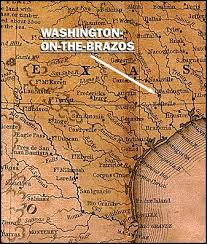 “Washington-on-the-Brazos, officially named Washington, in the upper northeastern corner of what is now Washington County, was a major political and commercial center in early Texas. The town was originally named Washington and began to be called Washington-on-the-Brazos or Old Washington only after the Civil War.
“Washington-on-the-Brazos, officially named Washington, in the upper northeastern corner of what is now Washington County, was a major political and commercial center in early Texas. The town was originally named Washington and began to be called Washington-on-the-Brazos or Old Washington only after the Civil War.
By 1835 Washington had become a supply point. Attracted by its location on the river and on or near major roads, merchants and tradesmen from neighboring communities settled in the new town. Washington's commercial growth resulted from provisioning emigrants to the interior and from the surrounding area's increasing agricultural development and population. The town was elevated on bluffs above the river and had a plentiful water supply from nearby springs; its location was therefore more healthful and less flood-prone than that of settlements at the river's edge. In December 1835 Washington became Gen. Sam Houston's headquarters and the concentration point for Texas army volunteers and supplies.
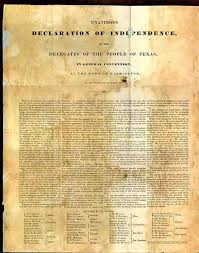 By 1836 the residents numbered approximately 100. To stimulate further growth, Washington businessmen offered an assembly hall without charge to attract the Convention of 1836 to their town. These town promoters rented the only structure large enough for deliberations, an unfinished building, from entrepreneur Noah T. Byars. Although the town had an inn, most delegates could not find lodging.
By 1836 the residents numbered approximately 100. To stimulate further growth, Washington businessmen offered an assembly hall without charge to attract the Convention of 1836 to their town. These town promoters rented the only structure large enough for deliberations, an unfinished building, from entrepreneur Noah T. Byars. Although the town had an inn, most delegates could not find lodging.
At Washington between March 1 and March 17, 1836, delegates signed the Texas Declaration of Independence, wrote the Constitution of the Republic of Texas, and established the ad interim government. To escape Antonio López de Santa Anna's army, the Texas government and the inhabitants of Washington evacuated the town.” More at: http://www.tshaonline.org/handbook/online/articles/hvw10
---------------
"The Birthplace of Texas"
“Washington-on-the-Brazos is known as "the birthplace of Texas", a distinction it earned when on March 1, 1836 it became the meeting place of the Texas delegates who formally announced Texas' intention to separate from Mexico and who drafted the constitution of the new Republic of Texas, organizing an interim government to serve until an officially elected government could be put in place.
Replica of the building at Washington-on-the-Brazos where the Texas Declaration was signed. An inscription reads: "Here a Nation was born".
“The delegates declared independence on March 2, 1836. Their constitution was adopted on March 16. The delegates worked until March 17, when they had to flee, along with the people of Washington, to escape the advancing Mexican Army. The townspeople returned after the Mexican Army was defeated at San Jacinto on April 21. Town leaders lobbied for Washington’s designation as the permanent capital of the Republic of Texas, but leaders of the Republic passed over Washington in favor of Waterloo, which later was renamed Austin.
Washington County was created by the legislature of the Republic of Texas in 1836 and organized in 1837 and Washington-on-the-Brazos became the county seat. Although the county seat moved to Brenham in 1844, the town continued to thrive as a center for the cotton trade until the mid-1850s, when the railroad bypassed it. The strife of the Civil War took another toll on the town, and by the turn of the 20th century it was virtually abandoned.”
______________
Washington-on-the-Brazos State Historic Site
“The 293-acre Washington-on-the-Brazos State Historic Site encompasses the site on Washington, the town which served as the Texas capitol from 1842 to 1845. Walking tours of the original townsite as well as a replica of Independence Hall are among the most popular activities.
The State of Texas purchased 50 acres (20 ha) of the old townsite in 1916 and built a replica of the building where the delegates met. The state acquired more of the site in 1976 and 1996.
Located between Brenham and Navasota off State Highway 105, the site is now known as Washington-on-the-Brazos State Historic Site. It covers 293 acres (119 ha), and features three main attractions, Independence Hall, Barrington Living History Farm and the Star of the Republic Museum, which is administered by Blinn College.
The site's visitor center is free and includes interactive exhibits about the Texas Revolution and the park's attractions, a gift shop, a conference center and an education center.
Barrington Living History Farm

The Barrington Living History Farm is a living museum farm homestead that represents the mid-19th century farm founded by Dr. Anson Jones, the last President of the Republic of Texas. Costumed interpreters raise cotton, corn, cattle and hogs using period techniques. The 1844 Anson Jones Home was moved to the site in 1936 as part of the Texas Centennial Celebration. The recreated outbuildings include two slave cabins, a kitchen building, a smokehouse, a cotton house and a barn. The farmstead opened in 2000, and is operated by the Texas Parks and Wildlife Department.
Washington-on-the-Brazos State Historic Site is revered as the site of the signing of the Texas Declaration of Independence on March 2, 1836. The park consists of the old town site and several museums. Located near College Station in east Texas, the grounds along the Brazos river provide a beautiful setting for sightseeing. For more information, visit http://www.tpwd.state.tx.us/spdest/findadest/parks/washington_on_the_brazos/
__________
The Big Picture! at Washington-on-the-Brazos for 175th
Thousands in Attendance for Texas Independence Day Celebration
“In recognition of the 175th anniversary of the signing of the Texas Declaration of Independence, the Star of the Republic Museum at Washington-on-the-Brazos, in partnership with the Arts Council of the Brazos Valley, unveiled The Big Picture! - a "Texas-sized" reproduction of the "Reading of the Texas Declaration of Independence," originally painted by artists Charles and Fanny Normann for the Texas Centennial in 1936.” More at: http://texas-history-page.blogspot.com/2011/03/big-picture-at-washington-on-brazos-for.html
____________
“In Houston, Washington Avenue was named after Washington-on-the-Brazos. It was the western route to Washington County. Following the present day road: Washington Avenue; Hempstead Highway; US 290 (Northwest Freeway) then outside of Harris County US 290 is called Houston Highway.”
__________
Brenham, TX
“Brenham is renowned as the heart of the bluebonnet region in Central Texas. The local chamber of commerce promotes the Bluebonnet Trails and offers free maps to guide visitors along the most scenic routes that also pass by historic sites and attractions.”
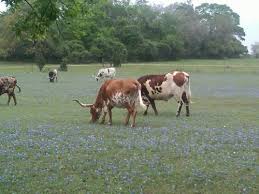
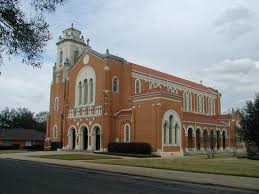

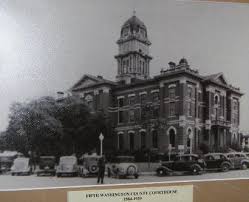 “As the county seat for Washington County, the county is also home of the "Birthplace of Texas," the site of the signing of the Texas Declaration of Independence on March 2, 1836 in the town of Washington. A TPWD State Historic Park is now located at the site.
“As the county seat for Washington County, the county is also home of the "Birthplace of Texas," the site of the signing of the Texas Declaration of Independence on March 2, 1836 in the town of Washington. A TPWD State Historic Park is now located at the site.
Brenham is also known for a German heritage festival that takes place each May called Maifest, similar to Volksfest.
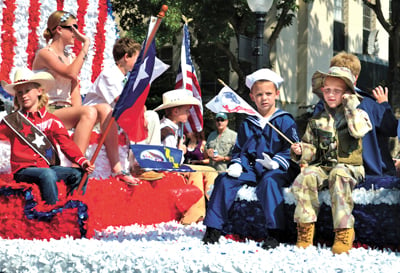
Junior Maifest Parade
Flag bearers representing the military and country flags wave to friends and family as they participate in the Junior Maifest portion of the parade Saturday. The Junior Maifest court was “A Make-Believe Adventure.”

Playful Melody
Accordion players Gene Hackemack (front) and Robert Herridge perform a playful melody on their instruments in the German tent at the Country Flavors Festival.

Melissa McCaghren/Banner-Press
Country Flavors Festival
Katie Paul laughs as she does a back flip on a trampoline bouncer Saturday during the Country Flavors Festival.
The festival was in its second year being combined with Maifest.
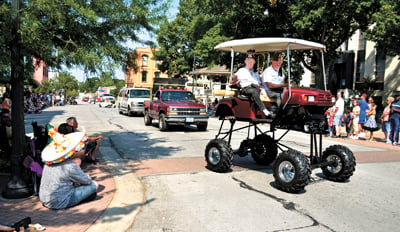
Melissa McCaghren/Banner-Press
Shiners appear at Parade
The Shriners take a ride on a retro-fitted golf cart Saturday at the parade. The Shriners appear annually at the Maifest parade.”
____________
On This Day:
First nickelodeon opens, Jun 19, 1905:
“On this day in 1905, some 450 people attend the opening day of the world’s first nickelodeon, located in Pittsburgh, Pennsylvania, and developed by the showman Harry Davis. The storefront theater boasted 96 seats and charged each patron five cents. Nickelodeons (named for a combination of the admission cost and the Greek word for “theater”) soon spread across the country. Their usual offerings included live vaudeville acts as well as short films. By 1907, some 2 million Americans had visited a nickelodeon, and the storefront theaters remained the main outlet for films until they were replaced around 1910 by large modern theaters.
Inventors in Europe and the United States, including Thomas Edison, had been developing movie cameras since the late 1880s. Early films could only be viewed as peep shows, but by the late 1890s movies could be projected onto a screen. Audiences were beginning to attend public demonstrations, and several movie “factories” (as the earliest production studios were called) were formed. In 1896, the Edison Company inaugurated the era of commercial movies, showing a collection of moving images as a minor act in a vaudeville show that also included live performers, among whom were a Russian clown, an “eccentric dancer” and a “gymnastic comedian.” The film, shown at Koster and Bial’s Music Hall in New York City, featured images of dancers, ocean waves and gondolas.
Short films, usually less than a minute long, became a regular part of vaudeville shows at the turn of the century as “chasers” to clear out the audience after a show. A vaudeville performers’ strike in 1901, however, left theaters scrambling for acts, and movies became the main event. In the earliest years, vaudeville theater owners had to purchase films from factories via mail order, rather than renting them, which made it expensive to change shows frequently. Starting in 1902, Henry Miles of San Francisco began renting films to theaters, forming the basis of today’s distribution system. The first theater devoted solely to films, The Electric Theater in Los Angeles, opened in 1902. Housed in a tent, the theater’s first screening included a short called New York in a Blizzard. Admission cost about 10 cents for a one-hour show. Nickelodeons developed soon after, offering both movies and live acts.”
_____________
Britain's King George V changes royal surname, Jun 19, 1917:
“On this day in 1917, during the third year of World War I, Britain’s King George V orders the British royal family to dispense with the use of German titles and surnames, changing the surname of his own family, the decidedly Germanic Saxe-Coburg-Gotha, to Windsor.
With the outbreak of World War I in the summer of 1914, strong anti-German feeling within Britain caused sensitivity among the royal family about its German roots. Kaiser Wilhelm II of Germany, also a grandson of Queen Victoria, was the king’s cousin; the queen herself was German. As a result, on June 19, 1917, the king decreed that the royal surname was thereby changed from Saxe-Coburg-Gotha to Windsor.
In order to demonstrate further solidarity with the British war effort, George made several visits to survey the troops at the Western Front. During one visit to France in 1915, he fell off a horse and broke his pelvis, an injury that plagued him for the rest of his life. Also in 1917, he made the controversial decision to deny asylum in Britain to another of his cousins, Czar Nicholas II of Russia, and his family, after the czar abdicated during the Russian Revolution. Czar Nicholas, his wife Alexandra and their children were subsequently arrested and later murdered by the Bolsheviks.”
_____________
Yesterday:
Jay called to say he was still sick, so I spent the day reading some Bible studies, researching stuff for this journal, the usual daily jobs, and taking care of the 5 animals here. It was a bit cooler, so Prime and Bobbiecat spent more time on the screen porch, and I could save some power with the doors and windows open longer in the morning.
Misty and I had our walk-about around here again, and a big friendly female dog, in season, was dumped off right in front of us. They said they didn’t want her anymore as she dug up their tomato plants. Call me sentimental, but I always carry one of my late dog’s leashes, so it came in handy. I put the probably already pregnant dog in a big carrier in the RVport with food and water. That saved a bunch of homeless pups from being born when the pound picked her up, as they will spay her before she is put up for adoption.
The two cat boarders are supposed to be picked up today.
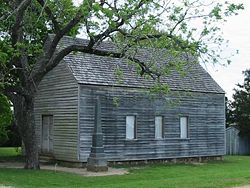



















3 comments:
It's just heart-wrenching when people dump off dogs for such flimsy excuses!
But, on the other hand, if they are that non-committed to having a pet, the pet probably had a horrible life there anyhow. At least she has a chance to get a new life... we hope.
My brother had a very heavy bellied stray female cat in his yard for about a week, and brought it to the vet for a go-over but not shots because he figured it was pregnant. Well, the vet said, nope, your cat is just FAT! HAHAHA He lucked out because on examination, the vet said it was also spayed. He has now had it for about 5 years and loves it so much.
So some animals do get "Happily Ever After"
You just reminded me of a song about a nickelodeon. Now for the life of me I can't remember how it goes. I will be stuck on trying to remember it for sometime. . .
Thanks for your comments, Karen and DD.
Karen, the poor dog was rather skinny, and looked like she hadn't been fed regularly, so she should be better off now. At least she won't be trying to have, and support, babies by herself now.
DD: "Put another nickel in, in the nickelodeon"
Happy Tails and Trails to all of you, Penny
Post a Comment